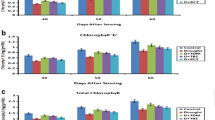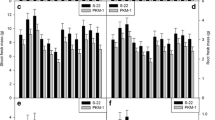Abstract
Germination and early seedling growth are important for establishment of maize because maize is chilling sensitive crop and low temperature during early period of growth can be detrimental to subsequent crop growth and productivity. Therefore, it is important to protect maize seedling from cold stress. A study was conducted on induced cold tolerance by 24-epibrassinoslide (EBR) at the Indian Agricultural Research Institute, New Delhi, India. Maize seedlings were raised in green house condition (25/18 °C day-night temperatures). Ten days old seedlings were treated with EBR (0.0, 0.01, 0.1, 1.0 and 10 μM) and then divided into two sets, one set was kept in greenhouse (25/18 °C day-night temperatures) and another was transferred to net house (cold stress). Data on various morpho-physiological traits was recorded after 7, 14 and 21 days of treatment. Exogenous application of 1.0 μM EBR had significant effect on growth and morpho-physiological traits under both conditions. The maize seedlings treated with EBR were more tolerant to cold stress than the untreated one. Significant increase in plant height, dry matter accumulation, chlorophyll content, total soluble proteins and starch contents was observed under both conditions, however, the results were more pronounced under cold stress. 1.0 μ M concentration being the most effective under both conditions. Maintenance of high tissue water content, reduced membrane injury index, increased total chlorophyll, soluble sugar and protein content were taken as the possible indicators of EBR induced chilling tolerance.


Similar content being viewed by others
References
Ali B, Hasan SA, Hayat S, Hayat Q, Yadav S, Fariduddin Q, Ahmad A (2008a) A role for brassinosteroids in the amelioration of aluminum stress through antioxidant system in Mung bean (Vigna rodiata L. Wilezek). Environ Exp Bot 62:153–159
Ali B, Hayat S, Faridudding Q, Ahmad A (2008b) 24- Epibrassinolide protects against the stress generated by salinity and nickel in Brassica juncea. Chemosphere 72:1387–1392
Allevi P, Anastasia M, Cevana R, Ciufferda P, Lado P (1988) 24-Epibrassinolide uptake in growing maize root segments evaluated by multiple selected ion monitoring. Phytochem 27(5):1309–1313
Antikainen M, Griffith M, Zhang J, Hon WC, Yang DSC, Pihakaski-Maunsbach K (1996) Immunolocalization of antifreeze proteins in winter rye leaves, crowns and roots by tissue printing. Plant Physiol 110:845–857
Aroca R, Tognoni F, Irigoyen JJ, Sanchez-Diaz M, Pardossi A (2001) Difference in root low temperature response of two maize genotypes differing in chilling sensitivity. Plant Physiol Biochem 39:1067–1075
Arora N, Bhardwaj R, Sharma P, Arora HK (2008) Effects of 28-homobrassinolide on growth, lipid peroxidation and antioxidative enzyme activities in seedlings of Zea mays L., under salinity stress. Acta Physiol Plant 30:833–839
Barr HD, Weatherley PE (1962) A re-examination of the relative turgidity technique for estimating water deficit in leaves. Aust J Biol Sci 15:413–428
Bhardwaj R, Arora N, Sharma P, Arora HK (2007) Effects of 28-homobrassinolide on seedling growth, lipid peroxidation and antioxidative enzyme activities under nickel stress in seedlings of Zea mays L. Asian J Plant Sci 6:765–772
Chen WP, Li PH, Chen THH (2000) Glycine betaine increases chilling tolerance and reduces chilling induced lipid peroxidation in Zea mays L. Plant Cell Environ 23:609–618
Clouse SD, Sasse JM (1998) Brassinosteroids: essential regulators of plant growth and development. Annu. Rev. Plant Physiol. Plant Mol Biol 49:427–451
Fariduddin Q, Yusuf M, Hayat S, Ahmad A (2009) Effect of 28- homobrassinolide on antioxidant capacity and photosynthesis in Brassica juncea plants exposed to different levels of copper. Environ Exp Bot 66:418–424
Farooq M, Aziz T, Basra SMA, Cheema MA, Rehman H (2008) Chilling tolerance in hybrid maize induced by seed priming with salicylic acid. J Agron Crop Sci 194:161–168
Feng Z, Guo A, Feng Z (2003) Amelioration of chilling stress by triadimefon in cucumber seedling. Plant Growth Regul 39:277–283
Grieve CM, Grattan SR (1983) Rapid assay for determination of water soluble quaternary aminocompounds. Plant Soil 70:303–307
Guy CL, Huber JLA, Huber SC (1992) Sucrose phosphate synthase and sucrose accumulation at low temperature. Plant Physiol 100:502–508
Haldimann P (1998) Low growth temperature-induced changes to pigment composition and photosynthesis in Zea mays genotypes differing in chilling sensitivity. Plant Cell Environ. 200–208
Hamada K (1986) Brassinolide in crop production. In: Maegregor P (ed) Plant Growth Regulators in Agriculture. Food Fertl. Technol. Cent. Asia Pac. Reg, Taiwan, pp 190–196
Hayat S, Ahmad A, Mobin M, Hussain A, Fariduddin Q (2000) Photosynthetic rate, growth and yield of mustard plants sprayed with 28-homobrassinolide. Photosynthetica 38:469–471
Hayat S, Ahmad A, Mobin M, Fariduddin Q, Azam ZM (2001) The level of carbonic anhydrase, photosynthesis and seed yield in mustard plants, treated with phytohormones. Photosynthetica 39:111–114
Hayat S, Ali B, Hasan SA, Ahmad A (2007) Brassinosteroid enhanced the level of antioxidants under cadmium stress in Brassica juncea. Environ Exp Bot 60:33–41
Hodge JE, Hfreiter BT (1962) In: Whistler RL, Be Miller JN (eds) Methods in carbohydrate chemistry. Academic, New York
Hola D, Langrova K, Kocova M, Rothova O (2003) Photosynthetic parameters of maize (Zea mays L.) inbred lines and F-1 hybrids: their different response to, and recovery from rapid or gradual onset of low-temperature stress. Photosyothetica 41:429–442
Ibrahim AMH, Quick JS (2001) Heritability of heat tolerance in winter and spring wheat. Crop Sci 41:1401–1405
Janda T, Kosa EI, Szalai G, Paldi E (2005) Investigation of antioxidant activity in maize during low temperature stress. Acta Biologica Szegediensis 49(1–2):53–54
Katsumi M (1991) Physiological modes of brassinolide action in cucumber hypocotyls growth. In: Cutler HG, Yokota T, Adam G (eds), Brassinosteroids Chemistry, Bioactivity and Applications, pp. 246–254. Am. Chem. Soc. Washington, DC
Kaurin A, Junttila O, Hansen J (1981) Seasonal changes in frost hardiness in cloudberry (Rubus chamaemorus) in relation to carbohydrate content with special reference to sucrose. Physiologia Plantarum 52:310–314
Lee TM, Lur HS, Chu C (1993) Role of abscisic acid in chilling tolerance of rice (Oryza sativa L.) seedling. I: Endogenous abscisic acid levels. Plant Cell Environ 16:481–490
Lee EA, Staebler MA, Tollenaar M (2002) Genetic variation in physiological discriminators for cold tolerance- early autotrophic phase of maize development. Crop Sci 42:1919–1929
Lowry OH, Rosebrough NJ, Farr AL, Randall RJ (1951) Protein measurement with Folin-phenol reagent. J Biol Chem 193:265–275
Lukatkin AS (2003) Contribution of oxidative stress to the development of cold induced damage to leaves of chilling sensitive plants: 3. Injury of cell membranes by chilling temperatures. Russian J. Plant Phsiol 50:243–246
Melkonian J, Yu LX, Setter TL (2004) Chilling responses of maize (Zea mays.L.) seedlings: root hydraulic conductance, abscisic acid and stomatal conductance. J Exp Bot 55:1751–1760
Milller GL (1959) Use of dinitrosalicylic acid reagent for determination of reducing sugar. Anal Chem 31(3):426
Rao SSR, Vardhini BV, Sujatha E, Anuradha S (2002) Brassinosteroids a new class of phytohormones. Curr Sci 82:1239–1245
Sasse JM (1991) In brassinosteroids – chemistry bioactivity and applications, pp. 158–166. A.C.S. Symp. Ser. (eds), Cutler HG, Yokota T, Adam G, A.m. Chem. Soc, Washington DC
Sasse JM (1997) Recent progress in brassinosteroid research. Physiol Plant 100:696–701
Schilling G, Schiller C and Otto S (1991) In brassinosteroids- chemistry bioactivity and applications, pp. 208–219. A.C.S. Symp. Ser. (eds), Cutler HG, Yokota T, Adam G, A.m. Chem. Soc, Washington DC
Staeblar MA (2001) Physiological responses to cold stress in maize (Zea mays L.) during early phase of development. M.S. thesis. Univ. of Guelph, ON, Canada
Sullivan CY (1972) Mechanisms of heat and drought resistance in grain sorghum and methods of measurement. In: Rao NGP, House LR (eds) Sorghum in the Seventies. Oxford and IBH Publishing Co, New Delhi, India, pp 112–120
Wang B, Zeng G (1993) Effect of epibrassinolide on the resistance of rice seedlings to chilling injury. Zhiwa Shengli Xuebal 19:53–60
Wellburn AR (1994) The spectral determination of chlorophyll a & b, as well as total carotenoids, using various solvents with spectrophotometers of different resolution. J Plant Physiol 14:307–313
Wilen RW, Sacco M, Gusta LV, Krishna P (1995) Effect of EBR on freezing and thermo tolerance of brome grass (Bromus inermis) cell cultures. Physiol Plant 95:195–202
Wise RR, Naylor AW (1987) The peroxidative destruction of lipids during chilling injury to photosynthesis and ultrastructure. Plant Physiol 83:272–277
Yokota T (1997) The structure, biosynthesis and function of brassinosteroids. Trends Plant Sci 2:137–143
Yu Jq, Huang LF, Hu WH, Jhou YH, Mau WH, Ye SF, Nogues S (2004) A role of Brassinosteroids in regulation of photosynthesis in Cucumic sativus. J Exp Bot 55:1135–1143
Yuanyuan M, Zhang N, Jiang L, Hongbo S (2009) Roles of plant soluble sugars and their responses to plant cold stress. Afr J Biotechnol 8:2004–2010
Zaidi PH, Yadav M, Maniselvan P, Khan R, Shadakshari TV, Singh RP, Pal D (2010) Morpho-physiological traits associated with cold stress tolerance in tropical maize (Zea Mays L.). Maydica 55:201–208
Aknowledgements
The authors are thankful to the Director, Directorate of Maize Research, IARI, Pusa Campus, New Delhi for providing essential facilities during the course of this investigation.
Author information
Authors and Affiliations
Corresponding author
Rights and permissions
About this article
Cite this article
Singh, I., Kumar, U., Singh, S.K. et al. Physiological and biochemical effect of 24-epibrassinoslide on cold tolerance in maize seedlings. Physiol Mol Biol Plants 18, 229–236 (2012). https://doi.org/10.1007/s12298-012-0122-x
Published:
Issue Date:
DOI: https://doi.org/10.1007/s12298-012-0122-x




